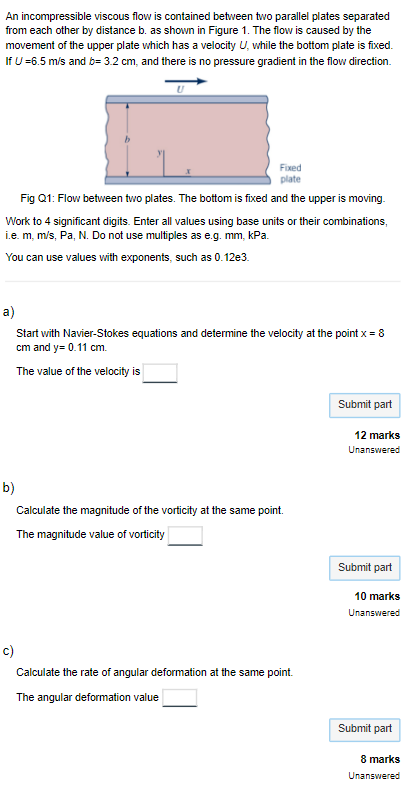Answered step by step
Verified Expert Solution
Question
1 Approved Answer
An incompressible viscous flow is contained between two parallel plates separated from each other by distance b. as shown in Figure 1. The flow

An incompressible viscous flow is contained between two parallel plates separated from each other by distance b. as shown in Figure 1. The flow is caused by the movement of the upper plate which has a velocity U, while the bottom plate is fixed. If U =6.5 m/s and b= 3.2 cm, and there is no pressure gradient in the flow direction. Fixed plate Fig Q1: Flow between two plates. The bottom is fixed and the upper is moving. Work to 4 significant digits. Enter all values using base units or their combinations, i.e. m, m/s, Pa, N. Do not use multiples as e.g. mm, kPa. You can use values with exponents, such as 0.12e3. a) Start with Navier-Stokes equations and determine the velocity at the point x = 8 cm and y= 0.11 cm. The value of the velocity is b) Calculate the magnitude of the vorticity at the same point. The magnitude value of vorticity c) Calculate the rate of angular deformation at the same point. The angular deformation value Submit part 12 marks Unanswered Submit part 10 marks Unanswered Submit part 8 marks Unanswered
Step by Step Solution
There are 3 Steps involved in it
Step: 1

Get Instant Access to Expert-Tailored Solutions
See step-by-step solutions with expert insights and AI powered tools for academic success
Step: 2

Step: 3

Ace Your Homework with AI
Get the answers you need in no time with our AI-driven, step-by-step assistance
Get Started


